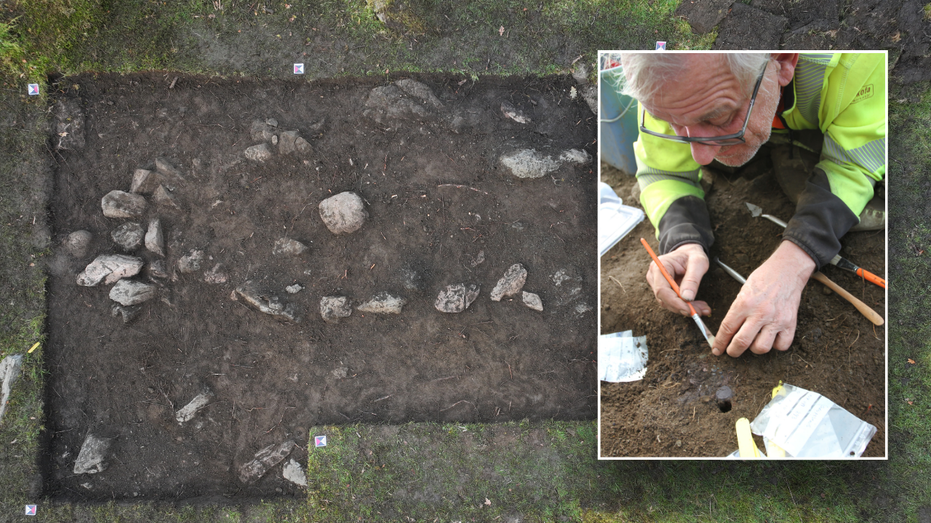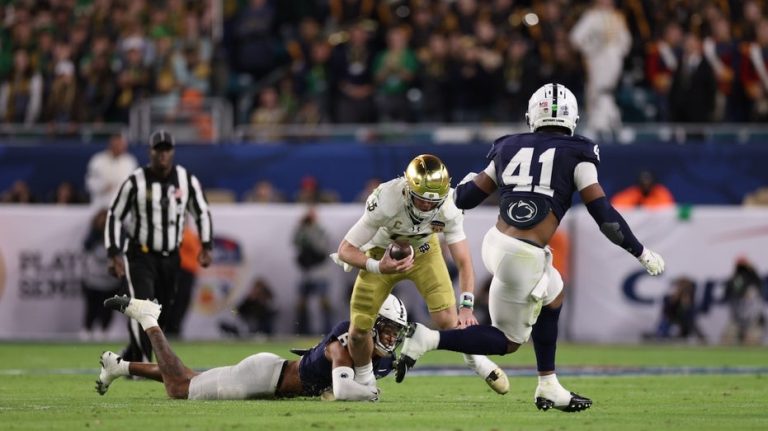Archaeologists recently unveiled remarkable artifacts from Viking graves in Norway — all thanks to a pair of metal detectorists who unwittingly stumbled across the treasure.
Søren Diinhoff, an archaeologist from the University Museum of Bergen, spoke to Fox News Digital about the discovery on Tuesday. The Viking graves were found at Skumsnes farm in Fitjar, located in southwestern Norway, in autumn 2023, but the initial excavation of the site wrapped up towards the end of last year.
Diinhoff said that the graves were found by members of the Bjørgvin Detector Club, who immediately alerted a local museum about the discovery. Archaeologists then set to work on excavating the first two graves, which both date back to between 800 and 850 A.D.
Diinhoff told Fox News Digital that both graves, which were filled with coins, jewelry and other treasure, belonged to wealthy women. In the first one, excavators found “fragments of jewelry indicating it had been a rich grave with significant grave goods.”
ARCHAEOLOGISTS STUMPED BY STRANGE ALIEN-LIKE FIGURINE DATING BACK 7,000 YEARS: ‘RAISES QUESTIONS’
“There were fragments of a couple of gilded oval brooches (also called tortoise brooches) of Norse origin, [and] fragments of a metal cauldron/dish produced in southern England or Ireland with enamel inlay and animal-shaped handles,” a summary of the first grave read.
One of the most interesting artifacts uncovered was a book clasp that the Vikings appeared to refashion as a buckle or brooch pin. Diinhoff explained that the clasp was likely raided from a Christian monastery on the Britannic Isles before the ninth century.
“They put a needle on the back of the clasps, and they could be used as brooches,” the expert described. “We think that the clasp in the first grave could very well have come from a Bible in England or Ireland. It had been ripped off and brought back to Norway where it eventually ended up as a woman’s brooch.”
Mostly fragments were found in the first grave because the site was likely plundered not long after the burial, Diinhoff said.
ARCHAEOLOGISTS UNCOVER ONE OF THE WORLD’S OLDEST CHRISTIAN CHURCHES
“We have a suspicion that the first grave was opened a long time ago. It may even have been opened in the Viking age,” he explained, adding that plundering graves was “not uncommon” during the Viking age, and that it was possibly done either to steal valuable items or to dishonor the dead.
“The finds were spread out in fragments in top and around the grave,” Diinhoff described. “The jewelry was broken to pieces, but the destruction was clearly not because of erosion. The fractured surfaces showed that the artifacts had been destroyed deliberately and most likely when the grave had been reopened.”
But the real treasure was found in the second grave, which included priceless artifacts ranging from textile production tools to high-class jewelry and coins.
“These tools indicate the buried had skills, but more show that the buried woman was the leader of the farm textile production. High-quality textile production was prestigious and an important financial income,” the report explained. “A bronze key found in the grave symbolizes this woman’s central position. She was the carrier of the house key and, as such, leader of the farm household. [What is] probably a frying pan in the grave shows the same.”
CLICK HERE TO SIGN UP FOR OUR LIFESTYLE NEWSLETTER
“Close to the brooches we found a pearl necklace,” the research report added. “It consisted of 46 glass beads of different European and Scandinavian origins, and between the pearls were placed 11 silver coins.”
One coin was minted in Jutland between 832 and 840 A.D., while the others were Frankish and produced under the reign of Louis the Pious, the son of Charlemagne. Louis died in 840 A.D.
Overall, Diinhoff said that trade between the Anglo-Saxons and Vikings was not uncommon, though not all “trade” was necessarily voluntary. He believes that the coins in the second grave were traded, while the book clasp was stolen during a raid.
For more Lifestyle articles, visit foxnews.com/lifestyle.
In total, archaeologists fully excavated the womens’ two graves, and were able to analyze a third one that was not fully excavated but contained a gilded brooch and 25 glass beads. Historians also believe that the decedents may have been part of the same Viking family.
Diinhoff noted that there was a sense of urgency in terms of excavating other graves at the site, of which there are at least 20.
“We fear that they will be destroyed in time,” the Viking expert said. “The are found just below the turf and there are so many ways they can be ruined…We hope to be able to excavate a few graves every year.”
Diinhoff also expressed gratitude to the metal detectorists who found the site.
“Without them ‘finding’ the site in the first place, we would not have known about the site,” the archaeologist said. “As the graves we found were just below the turf, they are very exposed and would likely have been lost in time. Now we get a chance to excavate this small gravefield.”





